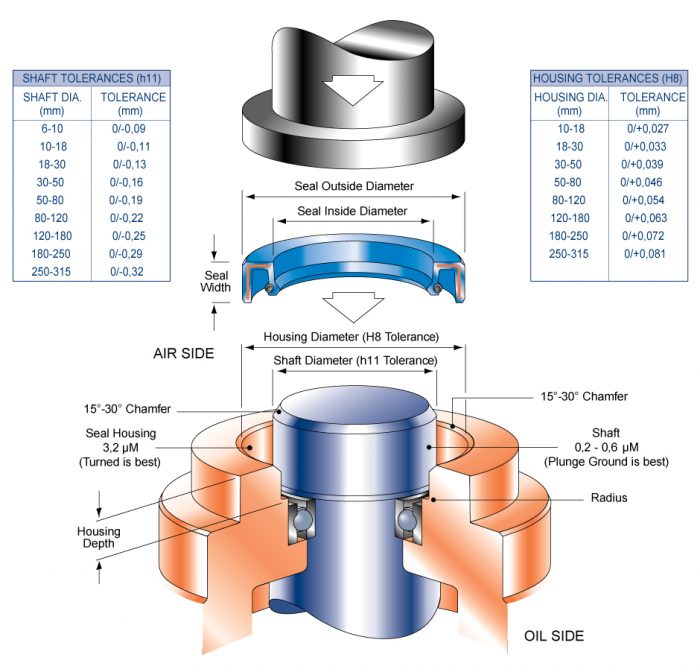What are Oil Seals?
What are Oil Seals – A guide to Oil and Rotary Shaft Seals
Also known as a Rotary Shaft Seal, Shaft Seal, Lip Seal, Elastomeric Lip Seal or any variation of these. It is a simple device for excluding dust, dirt, water or any other contaminant whilst retaining lubricant in rotary shaft equipment. Generally, it has been developed as a means of protecting the bearings of rotating shafts.
In this blog, we attempt to highlight what are Oil Seals and the various Rotary Shaft Seals including Mechanical Face Seals, Water Pump Seals, Gland Packings, and V-Seals that are readily available.
What are Oil Seals and how do they work?
The basic principle of sealing is straightforward – the flexible lip is held against the rotating part (usually the shaft) whilst the casing (or O.D.) is pressed into the housing or bore and holds the seal in place. The sealing lip needs some form of lubrication to avoid overheating and is usually energized by means of a garter spring.
What are Oil Seals and the different types?
Many – too numerous to list, covering a vast range of designs, sizes, and materials suitable for a never-ending range of applications. Some designs conform to International Standards such as BS1399 and DIN 3760 for metric sizes and seal types, but the majority have been manufactured to suit particular applications – hence the enormous selection available. This blog is intended to assist in this selection and will consider seal type, materials, and sizes.
What are Oil Seals and how should they be ordered?
The simplest way is to know either the preferred manufacturers part number, the overall sizes of shaft diameter, housing diameter and bore depth, or use our brochure to establish the M Barnwell Services ordering reference. Many of the old traditional names of seal manufacturers have either changed or disappeared in this age of “acquisitions”. If no longer available, we will advise you and offer a suitable alternative seal, from stock whenever possible. If your concern is getting the right seals for the job, you will need to know something about the application as well as the overall sizes. If you have any doubts – contact us, we will help in your seal selection.
What materials are available?
Leather is probably the oldest of the lip materials still in common use, but the move towards mass production methods has seen a massive increase in the development of synthetic rubbers which lend themselves to accurate and repeatable injection and compression moulding. Nitrile (NBR) is still by far the most common elastomer for “normal” use, whilst Viton® (FKM/FPM) is rapidly replacing Polyacrylate (ACM) and Silicone (VMQ) for high-temperature applications. Viton® also has high resistance to abrasion and chemical attack making it a preferred elastomer. Recent developments in the use of PTFE for Rotary shaft seals has caused widespread interest particularly for high-speed shaft rotation or poor lubrication applications.
How are they used?
Once you have selected the most suitable seal available, considering the environment, temperature, shaft speed, pressure, lubrication availability, as well as the size, of course, the seal should be stored adequately and then fitted properly. Here are a few suggestions that could help:-
Storage and Handling
There is a British Standard laid down for the control of synthetic rubbers. BS 3574 (1989) helps to determine shelf life – for instance, Nitrile (NBR) and Polyacrylic (ACM) are Group ‘B’ rubbers and have a 7-year life, whilst Silicone (VMQ) and Fluoroelastomers (Viton®) are Group ‘C’ rubbers and have a 10-year shelf life. PTFE and Leather do not come into this category but like the others should be kept in the original packing for as long as possible away from direct light, dust, and humidity. Ozone, which can also be produced by battery-driven forklift trucks has a very bad effect on synthetic rubbers. Finally, protect the sealing lip – DO NOT hang the seals on nails, wire etc.
Installation
If the seal is being fitted to original equipment you may have some influence over the shaft and housing bore finish, but if you are replacing a worn seal you still need to take into account the condition of these 2 essential parts. Check for sharp edges and burrs – particularly on the shaft and housing chamfers or you could ruin the seal before you start up. If the shaft is too worn consider using an M Barnwell Services Shaft Repair Kit.
Require More Knowledge?
For more information on the characteristics of Oil Seals click on some of the links below:
- Oil Seal Failure Checklist
- Popular types of Oil Seals
- Common Gas & Oil Seal failures
- Oilfield Elastomers
For more information visit our Oil Seals page, download the brochure or contact us today.
